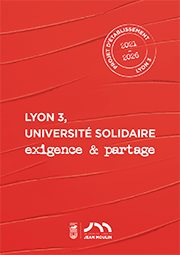AccueilRechercheProgrammes et productions scientifiquesThèsesThèses soutenuesThèses soutenues - 2023
-
Partager cette page
- Recherche,
- Philosophie,
- ?thique et développement durable,
BRET Florence
Ecrire une Vie de saint entre le IVe et le Vie siècle : étude de la formation d’un genre littéraire dans l’Antiquité tardive latine
Thèse en Lettres, soutenue le 4 décembre 2023.
Cette étude procède en trois temps. Il s’agit tout d’abord d’appréhender le processus d’autodéfinition du genre à travers l’examen du discours métalittéraire des textes. Cela nous permet de voir, à travers les emprunts assumés et les distances revendiquées, se dessiner un canon littéraire de la Vie de saint qui, à partir du VIe siècle, est suffisamment installé pour que s’esquissent des variantes au modèle formé, allant de la Vie-épopée longue et versifiée à la quasi-notice hagiographique à vocation pastorale.
Cette fixation du genre nous permet, dans un second temps, d’aborder la structure interne de ces Vies d’un point de vue transversal, en décomposant la structure en topoi ou briques littéraires qu’elles suivent, héritage de l’éloge classique. En évaluant le degré de refus, de reprise, de déplacement et de transformation des motifs antérieurs, ainsi qu’en détaillant le processus de stylisation selon différents modèles (grand homme, héros, philosophe, prophète, ap?tre, Christ), nous pouvons dégager quelle est la topique propre du genre, ainsi que la vision de la sainteté qui en ressort, fondée sur un apparent paradoxe : le saint est un être exceptionnel, mais sa vie doit pouvoir être imitée.
Cette tension constitutive du genre et sa visée exemplaire issue de la biographie classique nous conduit, dans un dernier temps, à nous arrêter sur le discours de transformation du monde que tiennent ces textes qui, par leur dimension orale, peuvent être re?us même par ceux qui ne lisent pas. De fait, à travers le saint souvent hors du commun, les Vies véhiculent des normes morales et théologiques à destination des moines, des rois, des fidèles en général. Elles incitent, à partir du milieu du Ve siècle, avant tout au culte des saints, pratique spirituelle à dimension physique, gr?ce à la proximité du tombeau et des reliques. En rappelant le pouvoir d’intercesseur et de protecteur du saint patron pour sa cité ou son monastère, elles appellent au pèlerinage, unissent les fidèles autour d’une forme de héros fondateur et ?uvrent au rayonnement géo-ecclésiologique de la communauté qui est à l’origine de leur écriture, dessinant, à travers l’espace régional, des réseaux de sainteté qui transcendent la limite de la mort.
La fin du texte est, en général, le moment de basculement, celui du récit à la prière. La principale innovation du texte est, finalement, de ne pas être la narration des hauts faits d’un mort, mais le rappel régulier, véritable actualisation, de ceux d’un homme vivant pour toujours au ciel, but que le lecteur, s’il se place dans les pas du saint, doit atteindre lui aussi.
Mots clés : Hagiographie ; Littérature latine ; Genre littéraire ; Biographie ; Narratologie ; Saint ; Antiquité tardive ; Haut Moyen ?ge.
The genre of the Life of saint was born in the fourth century and flourished in the Latin world thanks to a complex combination of circumstances: the success of the individual literary genre of the Vita during the Empire, the end of the persecutions, which means the end of the time of the martyrs, the development of the monastic movement and the gradual institutionalization of the Church in a world where Christianism is the religion of state. This thesis aims to study how the Vita sancti establishes itself in its own right over the first two and a half centuries of its existence, using a very large, therefore representative, corpus.
This study proceeds in three stages. Firstly, it looks at the process of self-definition of the genre by examining the metaliterary discourse of the texts. This allows us to see, through the borrowings assumed and the distances claimed, the emergence of a literary canon of the Life of a saint which, from the sixth century onwards, is sufficiently established to allow variants to be sketched out of the formed model, ranging from the long, versified epic Life to the hagiographical short note with a pastoral vocation.
This fixing of the genre allows us, secondly, to approach the internal structure of these Lives from a transversal point of view, by breaking down the topoi or literary bricks structure that they follow, a legacy of classical eulogy. By assessing the degree to which previous motifs are rejected, taken up again, displaced and transformed, and by detailing the process of stylization according to different models (great man, hero, philosopher, prophet, apostle, Christ), we can identify the specific rhetorical scheme of the genre, as well as the vision of sanctity that emerges from it, based on an apparent paradox: the saint is an exceptional being, but the reader should be able to emulate his life.
This tension, which is a constitutive part of the genre, and its exemplary aim, which stems from classical biography, lead us to focus on the discourse of transformation of the world held by these texts, which, because of their oral dimension, can be received even by those who do not read. In fact, through the often extraordinary person of the saint, the Lives convey moral and theological standards for monks, kings and the faithful in general. From the middle of the fifth century onwards, they encouraged the cult of the saints, a spiritual practice with a physical dimension, thanks to the proximity of the tomb and the relics. By recalling the power of the patron saint as intercessor and protector of his city or monastery, they encourage pilgrimages, unite the faithful around a kind of founding hero and work towards the geo-ecclesiological influence of the community that wrote them, creating networks of sanctity across the region that transcend the limits of death.
The end of the text is generally the turning point, the moment when the story turns to prayer. Finally, the main innovation of those texts is that they are not the narration of the deeds of a dead man, but a regular reminder, a real update, of the deeds of a man living forever in heaven, a goal that the reader must also achieve if he follows in the footsteps of the saint.
Directrice de thèse : Bruno BUREAU
Membres du jury :
- M. BUREAU Bruno, Directeur de thèse, Professeur des universités, Université Jean Moulin Lyon 3, Lyon,
- M. CUTINO Michèle, Rapporteur, Professeur des universités, Université de Strasbourg,
- Mme VEYRARD-COSME Christiane, Rapporteure, Professeure des universités, Université Sorbonne Nouvelle,
- M. GIOANNI Stéphane, Professeur des universités, Université Lumière Lyon 2,
- Mme ISAIA Marie-Céline, Professeure des universités, Université Jean Moulin Lyon 3,
- Mme PETERS-CUSTOT Annick, Professeure des universités, Université de Nantes.
Présidente du jury : Annick PETERS-CUSTOT







